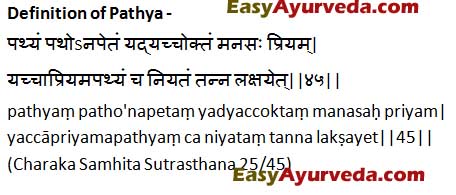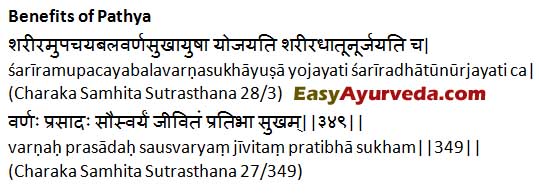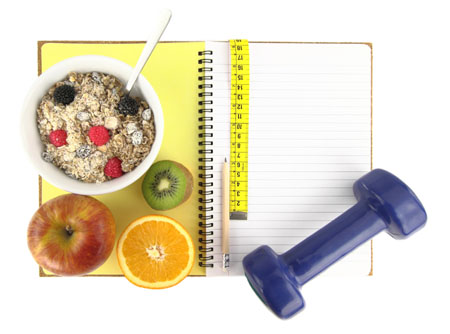Importance Of Diet (Pathya Apathya) For Specific Diseases
By Dr Renita D’Souza
“Do we have to follow any pathya (diet) in this treatment?” This is the usual question asked by patient in Ayurveda treatment. Reason can be either patient is eager to know the diet which help to overcome his disease or a little worried for which of his favorite dish doctor might cut off from his plate.
Table of Contents
Introduction
“Pathye sati gadaarthasya kimoushadha nishevanaih
Pathye asati gadaarthasya kimoushadha nishevanaih”
(Reference – Vaidya Jeevanam)
Vaidya Lolambi Raja indicated the importance of wholesome food (Pathya Aahara) by stating that if a patient intakes wholesome food then there is no need of medicine and if a patient continuously consumes unwholesome food then also there is no need of medicine. In the latter case, medicine will not be effective.
Diet importance
Why Ayurveda considers diet in treatment?
Food is considered one among the three pillars of life (Traya Upasthambha) –
Food, sleep and celibacy.
Thus Ayurveda emphasises on importance of food in maintaining health and curing diseases for promoting good health.
‘Cheeyate annadibh iti kaayah’ – Living body is formed by food.
Breakdown of tissues (dhatu) is the constant process taking place in the body which is replenished by intake of food.
Ayurveda considers following wholesome diet as powerful as medicine.
Acharya Vagbhata describes the importance of appropriate diet and regimen in treatment . He says – without following diet and regimen what is the use of giving medicine but if appropriate diet and regimen is followed along with medicine in disease condition then the treatment is complete.
Acharya Charaka mentions the word pathya also as synonym of chikithsa (treatment) Cha. Chi 1/3. This shows if wholesome food is taken in right time, quantity etc can help to recover from disease condition either alone or with other medications.
Wholesome regimen
Pathya

Pathya is derived from the word ‘Patha’- means the path.
Pathya is defined as that factor which is conducive to body and mind.
Pathya aahara is such diet which has beneficial effect over the body and mind of an individual without causing any untoward effect.
Apathya Aahara – Diet which is harmful to physical and mental well being.
Read – Similarities between Rasayana and Pathya (Healthy Diet)
There are three varieties of substances –
- Ekantha hita – which is absolute suitable for its continuous use without causing harm to the body.
- Anekantha hita – absolute unsuitable which harm the body in short period.
- Hitaahitha – whose which are suitable in some conditions and unsuitable in certain other conditions.
The word pathya is that which is suitable, causing neither increase nor decrease of the doshas but maintain normalcy.
Wholesomeness of diet is not only based on its quality or dose but also relies on the mental status and personal likings of person. Diet is more effective when it is taken willingly without any aversion towards it. Good diet is responsible for good mental status.
Read – How to maintain good mental health?
Diet selection
Criteria for determining the wholesome diet
Based on food
- Taste – sweet, sour, salty,pungent, bitter, astringent
- Guna (qualities) – heavy, light, unctuous, hot, dry etc
- Veerya(potency) – cold, hot
- Vipaka – It is the taste formed after digestion
- Prabhava
- Time – time of intake, collection, storage etc
- Place – place of its origin and place where you live
- Quantity and frequency of intake
- Combination with other food
- Mode of preparation
- Form of food – liquid, powder, paste etc.
Read – Bad Food Combinations And Solution As Per Ayurveda
Based on individual taking food
- Age
- sex
- Constitution of body digestive strength
- Mental status
- Place
- Climatic condition
- Season etc
Benefits
Effects of wholesome diet in Ayurveda

- Shareera upachaya – nourishes
- Bala varna sukha aayusha y – provide strength, complexion and happiness
- Shareera dhatu urjayathi – promotes growth of tissue elements.
- Prasadhah – clarity
- Sausvaryam – good voice
- Jivitham – longevity
- Prathibha – improve innovation skills
- Tusti pushtirbalam – nourishment and strength
- Medha – improves intellect
Individual possessing good health can only afford to perform activities which is beneficial to the individual as well as society leading to happiness in one’s life and salvation after death. As intake of beneficial diet in appropriate quality and quantity is one among the health promoting tool it can be considered as one of the basic factor for attaining happiness and salvation.
Read related – Foods That Increase Sattva, Rajas, Tamas: Srimad Bhagavat Geeta
Relation of food and disease
Disease is caused by various causative factors, intake of unwholesome diet is one of them. Unwholesome food does not produce disease immediately but in long run may cause certain health problems. This is so due to certain factors such as immunity, strength, tolerance capacity of individual etc.
Ayurveda recommended diet
Daily recommended Beneficial food for Healthy person
These diets are recommended for habitual intake is beneficial only if taken in appropriate quantity, quality and considering all criteria mentioned in selecting wholesome food in healthy person as mentioned in Ayurveda. Ghee is generally considered as wholesome but if it is taken in excess or during spring or in aggravated kapha condition will prove to be unwholesome.
Read – Is Ayurveda totally vegetarian?
- Shali – rice
- Shastika – rice grown in 60 days
- Godhuma – wheat
- Yava – barley
- Jangala – meat of animals living in forest area
- Pathya – Hareethaki (Terminalia chebula)
- Amalaka – gooseberry
- Mridvika – grapes
- Sharkara – sugar
- Ghritha – ghee
- Divyodhaka – rain water or pure water
- Khshira – milk
- Kshoudra – honey
- Dadima – pomegranate
- Saindhava – salt
- Triphala powder with honey and ghee consumed daily for improving eye sight
- Venu yava – seed of bamboo tree
Vegetables
- Patola – snake guard
- Balamulaka – tender raddish
- Cilli
- Vaasthuka
- Sunishannaka – Marsilea Quadrifolia
- Jivanti
- Tanduliyaka
- Mandukaparni
Read – 13 Hazards And Precautions Related To Vegetables As Per Ayurveda
Variety of legumes
- Mudga – green gram
- Vanamudgha – Phaseolus trilobus
- Makushtaka – Phaseolus aconitifolius – moth bean
- Kalaya
- Masura – Lens esculenta – lentil
- Mangalya
- Chanaka – chick pea
- Harenu – type of pea
- Aadhaki
- Satina
Read – Health Benefits Of Legumes Green Gram, Chickpea, Peas
Varieties of paddy
- Raktha shali
- Kanguka – kind of corn
- mukundhaka – type of grain
- Paanduka – species of rice
- Peethaka
- Pramodhaka
- Kaalaka
- Asana pushpaka
- Kardamaka
- Shakunaahrta
- Kalama
Variety of millets
- Nivaara
- Kodrava
- Uddhalaka
- Shyamaka
Varieties of deer
- Harina
- Kurangha
- Mrgamatrka
- shavadhamstra
- Karaala – variety of deer
Varieties of birds
- Krakara
- Kapotha – dove
- Lava – king quail
- Tittira – partridge
- Kapinjala
- Vartira
- Vartika
- References:
Ashtanga Hrudaya Sutrasthana, 8/24-25
Charaka Samhita Sutrasthana 5/12
Sushruta Sutrasthana 20/4-6 - Read related: How Much Food To Eat Per Day As Per Ayurveda?
Unwholesome food
Apathya – Unwholesome diet not recommended for daily intake
- Vallur – dried meat
- Sushka shaka – dry vegetables
- Shalluka – lotus rhizome
- Bisaani – lotus stalk
- Kresha mamsa – meat of diseased animal
- Kurchika – prepared by boiling curds/ milk/butter milk
- Kilata – inspissiated milk
- Shaukara – pork
- Gavya – cows meat
- Mahisha – meat of buffalo
- Matsya – fish
- Dhadi – curds
- Masha – blackgram
- Yavaka – variety of barley
- Reference: Charaka Sutrasthana 5/10-11
Following food are considered to be most unwholesome one among various categories (Charaka Sutrasthana 25/39)
- Pulses – black gram
- Ghee – ghee of sheep milk
- Milk – sheep milk
- Salt – ushara salt (which is collected from saline soil)
- Leafy vegetables – mustard
- Meat – beef
- Meat of birds – young dove
- Fish – cilicima
- Oil from – kusumbha (canthamus tinctorius)
- Vasa (fat) of – buffalow, crocodile, water hen, sparrow, elephant
- Fruit – nikucha (atrocarpus nikucha)
- Rhizomes – aaluka
- Phanitha – preparation of sugar cane
What causes food cravings?
We have cravings for different food or taste. It can be specific food craving like desire to eat sweets etc and non specific cravings like desire to eat anything this can be out of true hunger. Did you ever wonder why you have these specific food cravings. Lets explore what Ayurveda says regarding these cravings for food.
Read – Achara Rasayana – Behavioral Therapy For Calm Mind And Long Life
Due to particular constitution of body
- Vataja constitution people like sweet, sour and salty dishes (Read more – Vata Diet)
- Pittika constitution likes sweet and bitter (Read more – Pitta Diet)
- Kaphaja people like bitter, spicy and astringent taste (Read more – Kapha Diet)
Based on mental status
- Satvika person likes tasty food which is oily, stable, solid food of his desire, which increases life span, strength, health, happiness and satisfaction.
- Rajasika person usually like spicy, sour, salty food which is hot (ushna), penetrating (theekshna), dry, That which cause burning sensation, misery, suffering or disease.
- Tamasika individual likes cold food items, food which has lost taste (ghata rasam), which has foul smell (puthi), fermented food, which is sucked by others (uchistta) and spoilt food.
Other causes can be due to hormonal imbalance as seen in pregnant women having particular food cravings and also due to lack of certain nutrients, body craves for certain foods.
Diet in disease
Wholesome food in disease condition
Ayurveda considers following appropriate diet in particular disease is as powerful as medicine. Here are few diets which are beneficial in particular disease if taken in appropriate quantity either alone or in combination with other depending on doshas, stage of disease etc
Anorexia – wheat, snake gourd, grapes, pomegranate, rice (shali), green gram soup, tender radish, carrot, milk, buttermilk, ghee etc
Read related – Carrot (Gajar): Benefits, Remedies, Research, Side Effects
Dyspnea, asthma – cow’s ghee, pomegranate, old rice, wheat, horse gram, radish, goat’s milk, honey etc
Unwholesome diet in asthma – Roasted food, ice cream, curd, black gram, cold water, buffalo’s milk etc
Vomiting – lemon, grapes, gooseberry, laaja manda, old wheat, green gram, chick pea, radish, tender coconut water, dates, cumin seeds, cardamom, honey, coriander etc
Diarrhea – Old rice, barley, buttermilk, soup of green gram and lentils, roasted cumin seeds, pomegranate, goat’s milk, carrot etc
Read: 37 Ayurveda Home Remedies For Diarrhea
Pain abdomen – Old rice, milk, ghee, pomegranate, wheat, green gram soup, horse gram soup, cumin seeds etc
Burning sensation – Ash guard, snake guard, old rice, sandalwood, milk, green gram, banana, raisins etc
Gulma (abdominal tumor) – Old rice, gooseberry, garlic, asafoetida, ghee, grapes, cumin seeds, pomegranate, ginger, castor oil etc
Read related – Gulma- Abdominal Tumor- A Unique Disease In Ayurveda
Rheumatic arthritis – Old rice, horse gram, red rice (raktha shali), greengram, snake guard, ginger, warm water, drumstick, castor oil, meat of animals living in forest (jaangala mamsa), garlic etc
Cardiac disorders – Old rice, wheat, pomegranate, red rice, mango, grapes, goat’s milk, old jaggery, ginger, fresh buttermilk, asafoitida, bitter guard, snake guard etc
Renal calculi – Horsegram, green gram, wheat, ash guard, tender coconut water, old jaggery, sugarcane juice, barley, ginger, old rice etc
Tuberculosis – Food and drinks which are good to heart mitigate vata, easily digestible, shali, shastika, wheat, barley, ghee, honey, dates, raisins, gooseberry, jaggery, meat of partridge, cock, camel, bull, buffalow, milk, green gram soup etc
Diabetes – Barley, wheat, horsegram, bitter guard, pepper, garlic, jamun, turmeric, Triphala, amrutha (Tinosphora cordifolia), Lodhra (Symplocos Racemosa), Hareethaki (Terminalia chebula), sandalwood, snakeguard, green gram etc
Skin disease – Snakeguard, turmeric, bitter guard, neem, sandalwood, green gram, sareeva (Hemidesmus indicus), vaca etc.
Food prohibited in skin disease – fish, jaggery, sesame, milk, curd, sour food items.
Heamorrhoids – Buttermilk, ghee, pomegranate, shali rice, green gram, onion, banana, butter, goat meat, asafoetida, triphala, greenleafy vegetables,carrot etc
Fever – Raktha shali (Red rice), shastika shali, snake guard, green gram, warm water etc
Read related: Ayurveda Lifestyle and Diet For Fever – 45 Important Things To Know
Studies done
Research on diet:
Researches found that nearly half of all the deaths in the United States in 2012 that were caused by cardiometabolic diseases were associated with sub-optimal eating habits. Having excess of sugar, salt and fat in diet can be injurious to cardiac health. (1)
A research paper published in The British Medical Journal concluded –
Chronic disease risk can be prevented with fruits, vegetables, whole grains and fish and lower consumption of red and processed meats and sugar sweetened drinks
Higher consumption of nuts, legumes, vegetable oils, fermented dairy products, and coffee are further likely to confer benefit (3)
Click to Consult Dr Renita D’Souza
Added information
Further addition by Dr MS Krishnamurthy MD (Ayu), PhD
In practice whenever Pathya (wholesome diet and habits) and Apathya (unwholesome diet and habits) words are usually associated with Ayurvedic medicine and treatment. Even Unani, Siddha and Homeopathy has also some diet rules as part of treatment.
People think that Pathya and Apathya are not applicable to Allopathic medicines. Quite interestingly, even the allopathic physicians do not usually prescribe such restrictions or do not advice anything that is mandatory during their medication!
Read: Eating Etiquette: Healthy Eating Rules

What is the reason behind this?
1. Allopathic system and related texts do refer and recommend several such wholesome and unwholesome food and habits in most of the illness cases. Even in their teaching and treatment protocol this is well explained. But diet rules are seldom advised by allopathic doctors.
People who take alloapthic medicines also believe that following Pathya rules is not mandatory. But they also agree that having a plant based diet reduces the risk of heart diseases ((3)
Read related: Health Benefits Of Vegetarian Diet – Ayurvedic Opinion
2. Even though the texts refer several food and vegetables and other eatables with reference to specific disease contexts, well defined explanations are not found in any texts which is an hindrance to such recommendations.
Also particular molecule or compound or their combinations in totality how they mutually react with the food is not well defined and hence doctors are in dilemma what to advice and what not to, with respect to pathya and apathya.
Whereas all these points are well explained with strong ayurvedic principles and narrations in each contexts.(That is why ayurvedic books like Charaka-Sushruta Samhita-Vagbhata-Bhavaprakasha-Kaiyyadeva-Yogaratnakara etc refer different chapters to narrate the quality-property-advantages and disadvantages in each level like Dosha, body type, disease, stage of disease, region of the patient, medicine etc. )
The allopathic system looks food in terms of chemical compounds like proteins, carbohydrates, fats, etc. whereas Ayurveda even considers the physical aspects such as hot / cold, heavy to digest, light to digest, unctuous, dry etc.
The primary belief of Allopathic doctor lies with the medicines that he prescribes. The primary belief of an Ayurveda doctor lies in patient’s innate ability (immunity) in fighting disease and then on foods, and then on therapies and medicines.
In fact in recent days dietetic and neutraceutics itself taking priority in treatment and many allopathic doctor oppose such ideologies; according to them only medicines will work and not the food and beverages.
Many physicians believe that the medicinal potency is 100 or 1000 times more than the food. But body immunity can be built more appropriately from food and not by merely with medicines of prolonged period.
Only diet part that allopathic doctors prescribe is, if the medicine reacts with food.
Criteria for pathya, apathya
Ayurvedic principles of Pathya and Apathya is advised as per patient’s
Desha – habitat
Dosha – dominant Dosha that is causing disease.
Bala – strength of the patient
Kala – current season and also duration of illness. Eg: Read season based diet rules for summer
Prakruti – natural body type of the person.
Satwa – tolerance capacity of the patient
Vyadhi – diet related to specific disease. Eg: Diet for chronic asthma
Oushadha – diet based on nature of medicines. Eg: Hot water along with ghee or oil based medicines.
Broad mindedness (leaving the System related bias), community oriented approach (leaving commercial thinking), holistic thinking (not treating mere the disease but also the whole body itself, including the due consideration of mind), incorporation of traditional knowledge etc will surely help the sufferers to the maximum extent.
Read – How To Do Fasting? A Step By Step Guide For You
Probably this may reduce even the toxic effects/undesired effects of the drugs, chances of drug resistance/intolerance, in prescription of minimum drugs and utilization of the best available medicinal resources too.
Read related: 11 Ayurvedic eating tips for good health
If carried so, I suspect, even the medicines/molecules( of allopathic system) which we have discarded on account of toxicity or untoward effect can also be reused/re-practiced which will remain as a boon to those pharmaceutical companies too.
I wish and eagerly watch for such a delightful day.
I am open to discuss any debatable matter in this respect.
Click to consult Dr MS Krishnamurthy MD (Ayu), PhD
Addition by Dr JV Hebbar
Diet Plan In Ayurveda Treatments
Ayurveda Diet plan is an integral part of Ayurvedic treatment of diseases. Your Ayurvedic specialist is correct in advising you on dietary restrictions, which is part and parcel of any Ayurvedic treatment.These dietary restrictions help in –
– Preventing further progress of the disease condition. For example – having turmeric in the diet helps to avoid further development of allergic complications.
– Aiding for better action of the Ayurvedic medicine – For example, having pomegranate juice helps in relieving ulcerative colitis
– Relieving the cause of disease condition – water fasting helps you eat less and thus avoid obesity.
– Overall improvement of general health. – Having regular Triphala churna provides the body with natural antioxidants and makes the body toxin free and sturdy.
A simple example of dietary restriction might be: To avoid oily stuff and junk foods while someone is on treatment for obesity.
So, I advise you to try and follow the dietary restrictions as much as possible.

What happens if you do not?
In some Ayurvedic treatment schedules, the doctor might include the diet plan as part of the treatment. In that case, the treatment will be less effective if the Ayurveda diet plan is not followed as prescribed. But if the diet plan is only an accessory part of treatment, there might not be much effect of diet plan over the overall success of the treatment. It is always better to stick to the diet plan suggested by the Ayurvedic doctor.
If you cannot follow the diet restrictions suggested by the doctor, then, it is better to ask the doctor for substitutes or any other suggestion to counterbalance the treatment. But following the diet plan adds more resilience and will power in you to fight the disease better.
Dosha Diet for healthy people
Is it logical to have Vata Diet, Pitta Diet and Kapha Diets for healthy people?
Dr JV Hebbar
Here are a few considerations with respect to the Dosha diet. A typical healthy diet will have a mix of ingredients which address the three doshas in different manners.
Lentils (dals) cause gas build up in the intestines. Though they are nutrition rich and support Kapha dosha, because of the gas issue, they increase Vata Dosha.
But, if they are cooked with sesame oil or any cooking oil, then oiliness of sesame may counter the Vata increasing quality of lentils and dals.
Or if garlic, dill seeds, fennel, cumin etc. anti-bloating spices are added to the dish, these will counter the Vata aggravating effect of lentils.
Similarly, use of spices can increase Pitta Dosha but if ghee is used in the dish, then it will decrease the Pitta increasing effect to a great extent.
Read: Eating Etiquette: Ayurvedic Healthy Eating Rules
Rice, which is the staple food of south India can potentially increase Kapha dosha, but use of pickles, spices in diet decreases the Kapha dosha.
It is very rare for a person to be purely of Vata type. Most of us have two doshas dominant in us.
Made with any ingredients, if the net effect of the dish is spicy and hot, it will decrease Kapha dosha and can increase Vata and Pitta Dosha.
If the net effect of the dish is coolant, then it balances Pitta dosha but can increase Vata and Pitta dosha.
Oily and hot foods are generally considered nutrition rich and open up body channels. Oily and cold foods – such as prepared with coconut oil, or oily food that is refrigerated, makes the food nourishing, but it can block the channels, especially in rainy and cold weather.
Refrigeration of dishes makes it Kapha-aggravating and can potentially weaken Agni – digestive fire.
Read: Diet And Lifestyle For Women In Ayurveda
Sweet, sour and salt ingredients increase Kapha Dosha but decrease Vata.
Spicy, bitter and astringent – increase Vata but decrease Kapha.
Astringent, bitter and sweet tasting ingredients decrease Pitta but spicy, saline and sour ingredients can increase Pitta.
Overall, If the food is oily, it can increase Pitta and Kapha and if the food is drying, (that causes immediate dry mouth, dry throat), can increase Vata.
If the food is cold, it can increase Vata and Kapha and decrease Pitta. If food is hot and spicy, it is the reverse, it can decrease Vata, Kapha and increase Pitta.
Nutrition is the primary aim of food. Nutrition, nourishing is a Kapha dosha activity. So, all foods primarily support or increase Kapha dosha.
Read: How Much Food To Eat Per Day As Per Ayurveda?
It is practically impossible to pick all vata balancing ingredients in a Vata diet for a Vata person. Irrespective of Dosha dominance, as long as the person is healthy, the net effect of food should be tridosha balancing, though individual ingredients may have many different effects.
If the person has a specific disease due to an increase of specific Dosha, then a dosha based diet, with hand picked ingredients, that are useful to target that particular disease makes sense.
For example, in the case of weak digestion, obesity with cold and cough, Kapha dosha is increased, so, the diet should ideally be spicy.
These are a few considerations for designing a dosha based diet.
Learn more about Ayurveda dietetics with our weekend classes










6 comments
Pramod
For pinworms should we eat raw garlic 1 to 2 cloves at empty stomach in morning,and how many days we should eat garlic?
Please reply,
Thanks.
Dr J V Hebbar MD(Ayu)Author
Usually garlic is taken after frying with ghee.
Ankita
what exactly is ‘kilata’?
Dr J V Hebbar MD(Ayu)Author
Kilata is like paneer, prepared from milk cream.
shyne
Is Paneer a good food dr?
Dr J V Hebbar MD(Ayu)Author
Yes. Bit heavy to digest, improves Kapha Dosha, decreases Vata and Pitta DOsha.
Read more about it here
https://www.easyayurveda.com/2011/01/15/what-is-paneer-how-to-make-paneer-paneer-recipe/